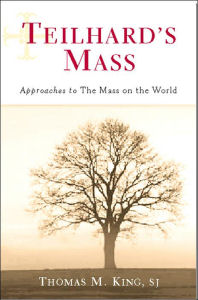
|
Posted September 5, 2005
Book: Teilhard’s Mass: Approaches to “The Mass on the World” Author: Thomas M. King, S.J. Paulist Press, NY, pp.172 An Excerpt from the Jacket:
Furthermore, Teilhard’s Mass shows how a Christian can transform one’s life and death into an all-embracing Mass on the Altar of the World. A recent encyclical on the Eucharist speaks of every Mass having “a cosmic dimension.” This book enables those interested in the liturgy to understand the claim. An Excerpt from the Book: Teihard wrote the first of the essays that would make him famous when he was thirty five years old and serving in the French army during World War I. He called it “Cosmic Life” to affirm that the cosmos itself is alive. Early in the essay he recalls several moments when the universe seemed to summon him. On one such occasion he was gazing over a dreary expanse of desert and heard the call, on another he was watching the waves of the ocean, and on a third occasion he felt called to lose himself in the shadows of a deep forest. At all such moments he felt possessed by a yearning to let go of the anxieties and toil of life, relax, and sink back into the world that had cradled him: “Matter was calling me.” The earth itself appeared as the “indestructible essence from which all emerges and into which all returns, the starting point of all growth and the limit of all disintegration.” So he allowed himself to drift into matter, believing his “over-tense activity might indefinitely become ever more relaxed.” As he released his hold of himself he more or less dissolved into a bliss-giving repose. He had decided to merge with the great All thinking, “If I was to be All, I must be fused with all.” His conscious mind was slipping into what Sigmund Freud would call “oceanic feelings.” But as Teilhard drifted downward he suddenly stopped: “It was then that faith in life saved me.” Without explanation he reversed direction, made a “complete turnabout,” and announced, “We must travel with our backs turned to matter and not try to return to it an be absorbed into it.” His effort to relax and dissolve was “hopelessly mistaken,” he had gone “completely astray.” After his reversal he would identify with the tense and rising current of life, the current known as evolution. Evolution is seen as a movement away from dissolution and into ever more complex structures; it is a movement to consciousness and freedom, to “absolute fuller being.” These two movements, one that would relax into dissolution and nothingness and the other that wold struggle toward greater complexity and beng, underlie all of Teilhard’s thought. He would connect the first with entropy and the second with evolution, and his writings would abundantly contrast the two currents. The two movements would lead to very different goals: entropy would lead to a materialist pantheism (god identified with matter), while evolution would lead to a spiritual pantheism (God as the Soul unifying all things). He would see this spiritual pantheism to be consonant with Christianity and spoke of a “Christian pantheism,” for St. Paul had spoken of a future when God would be “All in all.” Table of Contents: 1. Teilhard and the priesthood 2. The transformation of the world in science and in the Mass 3. The scientific work of Teilhard while writing “The Mass on the World” 4. The Mass and salvation of the world. 5. A commentary on passages from “The Mass on the World” 6. The “Mass” and adoration 7. The “Mass” and the apostolate Appendix I: “The Mass on the World” by Teilhard de Chardin Appendix II: A prayer service based on “The Mass on the World” Appendix III: To pray as Teilhard Prayed |
|
